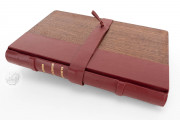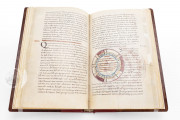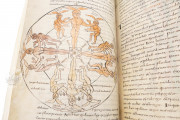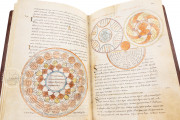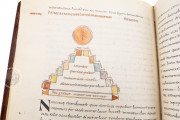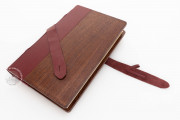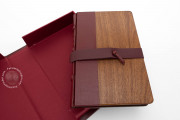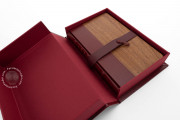The Laon Computistical Miscellany is a handsome manuscript of texts for understanding the reckoning of time and identifying the constellations, which opens with On the Nature of Things by Saint Isidore. Added to this core, which dates from the second quarter of the ninth century, are excerpts from Isidore's Sentences concerned with righteous human behavior and other texts, some copied as late as the end of the century. The manuscript was compiled in northern France, perhaps at Laon. The computistical texts boast more than sixty colored diagrams and drawings.
The Laon manuscript's contents—derived from the writings of various early Christian authorities—reveal that Christian scholars of the Carolingian period were keenly interested in examining the natural world for what it could reveal about divine order. Among the topics is the measurement of time, which was crucial in establishing the Christian calendar, especially the date of Easter.
The "Book of Wheels"
Saint Isidore's On the Nature of Things, a seventh-century treatise on natural history, was known in the Middle Ages as the "book of wheels" for the circular diagrams that formed an integral part. Two of the Laon manuscript's wheels are populated by androgynous human figures: twelve (all with wings on their heads) representing the winds (fol. 5v) and four portraying the seasons (fol. 6v).
The artist has used color cleverly to enhance the representation of the seasons. Spring and autumn are half blue and half orange (to indicate the occurrence of the equinoxes in those seasons), and winter (at left) is icy white. The same artist must have been responsible for the image of the first day of Creation depicted as a human, half blue and half orange (fol. 41v). An inscription explains that Creation began on March 25, the date of the spring equinox.
Reading the Stars
The most densely illustrated portion of the manuscript is the description of the night sky's constellations, with forty-one pictured on nine pages (fols. 26v-30v). The animal and human figures are lively and colored in rusty orange and blue washes. The centaur is particularly engaging: he holds an animal (the constellation bestia) in his outstretched arm, and a rabbit dangles from the spear over his shoulder (fol. 30v).
Historical Script for Inscriptions
At least four scribes contributed to the miscellany over the course of decades, all writing in Caroline Minuscule, the highly legible script introduced into northern Europe in the waning years of the eighth century. Headings and some of the inscriptions in the diagrams are in display scripts. Some are in pure Uncial, a script favored for Christian texts in late antiquity.
In a Cathedral Library
Although we do not know where the miscellany was copied, it was in the library of the cathedral of Notre-Dame at Laon by the mid-eighteenth century. After the French Revolution, the manuscript entered the collection of the Bibliothèque communale of Laon (later the Bibliothèque municipale and now the Médiathèque Suzanne-Martinet). The manuscript's quarter binding of brown leather over exposed wooden boards has been restored.
We have 1 facsimile edition of the manuscript "Laon Computistical Miscellany": Isidorus Hispalensis facsimile edition, published by Incipit, 2023
Request Info / Price


